11 Best first-time Europe itineraries for 1, 2, or 3 weeks
Europe is going to be very busy in the summer of 2024 as the world is back to normal and travel demand is higher than ever. One other key factor is that most European currencies are still hovering at lower levels historically compared to the US dollar, which means that Europe will feel somewhat cheap again this year. In fact, according to our World Backpacker Index, European cities like Lisbon, Madrid, and Munich are about 30% cheaper to visit than Boston, Chicago, and New York City. In other words, flying to Europe might seem expensive, but most things will be cheaper once you get there compared to the costs of visiting a large US city.
Below you’ll find 11 of the most popular and best itineraries for a first visit to Europe. Your first visit is not really the time to be different or creative, and the famous destinations tend to be popular for a reason. In other words, it’s kind of silly to visit, say, Bulgaria, if you’ve not yet been to France or Italy. I lay out the best options along with how long to stay in each place as a general guide. I also discuss Mediterranean cruises, which can actually be an amazing way to see a lot of Europe on your first visit, especially if you don’t like going back and forth to train stations and airports every 2 or 3 days.
For a bit of fun you might be interested in the cheapest 5-star hotels in Europe, which start at US$80 per night for really nice hotels. It helps show that if you choose some of the cheaper cities, you can treat yourself to some luxury that you can’t afford in most other places.
This article was last updated in March, 2024.
There are 11 starter itineraries described in detail below
- Classic London and Paris
- England and Scotland
- Paris and Italy
- Mediterranean cruise
- France, Belgium, and Netherlands
- Paris and elsewhere in France
- Italy
- Spain
- Germany
- Switzerland
- Best of cheap eastern Europe
For each itinerary there are suggestions of other destinations that are easy to add on to the main cities.
Note: This article was most recently updated in March, 2024
Building the best itinerary for your first trip to Europe
Below there are 11 popular itineraries for one week in Europe. If you’ve only got a week then choose one of them and assume you’ll return again to conquer more of this amazing part of the world. If you’ve got more time then you can choose from some of the top add-on suggestions for each one.
Start in the most famous cities
Your first visit to Europe is no time to try to be different or edgy. I recommend that you focus on these 5 great cities before you start branching out into cheaper or more obscure places.
Keep your travel days to a minimum
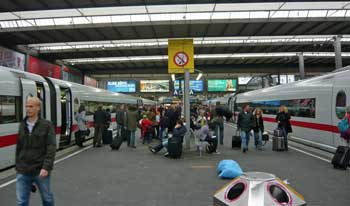
Spend 3 (or 4) nights in almost every major city
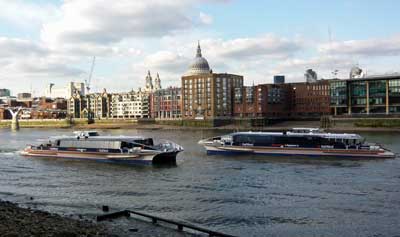
So many first-time visitors are initially planning on spending only 1 or 2 nights in major cities that I wrote a detailed explanation of why 3 nights is ideal for almost all European cities, even if you want to see as much as possible.
3 (or 4) nights will be enough for any city on your first trip
Most first-time visitors are tempted to move too quickly, but it can also be a mistake to move too slowly. It’s really amazing how much you can see in two full sightseeing days. If you spend too long in one city you’ll end up seeing things that are way down your list, while you could be in another city seeing things at the top of your list there.
Choose cities that are easy to reach from each other
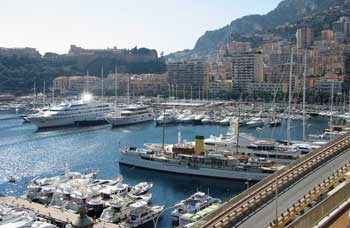
For your first trip it’s best to visit cities that are no more than a 5-hour train ride apart.
Choose cities that are connected by reasonable train rides rather than flights
To build on the point above, finding cheap flights within Europe is easy, but train travel is about a million times more enjoyable and less stressful. You’ll enjoy the train rides almost as much as the cities, so focus on places that are within 5 hours of each other by train.
Start with one of the classic itineraries below, and then add to it if you have more time
If you only have 7 days then you’ll find a list below of classic itineraries that are well-suited to a first visit to Europe. Hopefully you have more than 7 days though, and if you do you can add in one or more of the suggested add-on cities to build an itinerary that appeals most to you.
Best 1-week itineraries for the first time in Europe
Itinerary 1: Classic London and Paris
Fly into either city and take the 2-hour Eurostar train between them
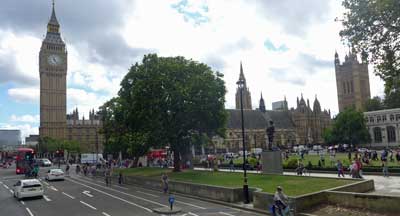
London highlights
- Big Ben and Parliament
- Westminster Abbey and St. Paul’s Cathedral
- Tower of London and Tower Bridge
- West End shows (Broadway equivalent) and classic pubs
- Buckingham Palace and Windsor Castle
Paris is actually far more beautiful than London and the food is famously much better as well. Since Paris gets so many tourists from non-French speaking countries, it’s easy to get by on just English, and the Metro system makes it fast and easy to get around. The architecture of both cities is amazing from the Tower of London, Big Ben, Westminster Abbey to the Louvre and the Eiffel Tower. These cities each pack a huge punch and they are very different from each other as well. Actually, England is arguably the best choice for your first trip to Europe.
Paris highlights
- Eiffel Tower
- Louvre Museum and Museum de Orsay
- Arc de Triomphe and other monuments
- Montmartre neighborhood and Sacré Coeur Cathedral
- Probably the world’s best affordable restaurants and wine
Best add-ons to London and Paris
- Edinburgh (2 or 3 nights, from London)
- Amsterdam (2 or 3 nights, from Paris)
- Bruges and Brussels (2 nights, from Paris)
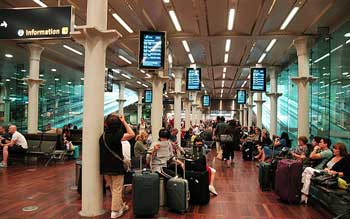
>>>Best one-week London and Paris itinerary in detail
>>>Check London hotel deals
>>>Check Paris hotel deals
Itinerary 2: England and Scotland
- London (3 or 4 nights)
- York (1 night)
- Edinburgh, Scotland (2 or 3 nights)
- Inverness, Scotland (2 or 3 nights)
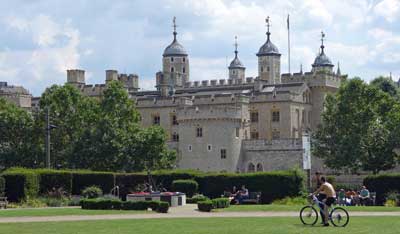
York is a small Roman city with intact city walls and one of the most famous cathedrals in Europe. Edinburgh is not only the capital of Scotland, but it’s easily the second most interesting city in all of Britain. If your time is short, skip York and spend more time in Edinburgh.
If you prefer to focus on the south of England on your first trip then the best option is to go to Bath or nearby Bristol after London. Bath is another of England’s top destinations and it’s a gorgeous city that has been a spa resort for many centuries. It’s also reasonably close to Stonehenge. You can also easily get to Cornwall in England’s southwest corner from Bath, and that’s a whole different and fascinating experience (with nicer weather than up north).
If you’ve got more than a week and want to spend more time in Scotland, especially in the summer months, the place to head to is Inverness. It’s a small town that is considered the gateway to the Scottish Highlands, but it’s an interesting and charming place on its own. You can take day-trips by bus to the highlights of the Highlands including the Isle of Skye and Loch Ness. Between you and me, it’s better to minimize time in Loch Ness or skip it altogether because it’s not one of the more photogenic parts of Scotland and the monster has always been a hoax.
Travel times between the recommended places
- London to York by train: 2 hours
- York to Edinburgh by train: 2.5 hours
- London to Edinburgh by train: 4 hours
- Edinburgh to Inverness by train: 3.5 hours
- London to Bath by train: 85 minutes
Best add-ons to England and Scotland
If you think you want to spend your whole trip in Britain you should have a look at our article on the best itineraries in England, Scotland, and Wales.
>>>Check London hotel deals
>>>Check Edinburgh hotel deals
Itinerary 3: Paris and Italy
- Paris (3 or 4 nights)
- Venice (1 night)
- Florence (2 or 3 nights)
- Rome (3 nights)
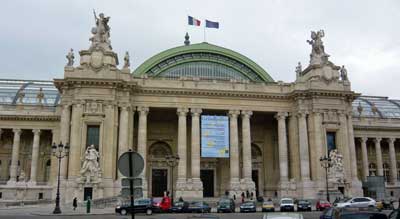
From Paris you can easily fly to Venice (or nearby Treviso) where you should try to spend about 24 hours. Venice is small enough to see in a full day, and so crowded that most people are satisfied to leave after that day. The key is to stay in the main part of the main island so you can enjoy Venice before the cruise passengers and day-trippers arrive, and also after they leave for the day. Two nights in Venice would not be wasted time, and it’s possibly the most gorgeous city in the entire world, but you can see the best of it in a bit over 24 hours.
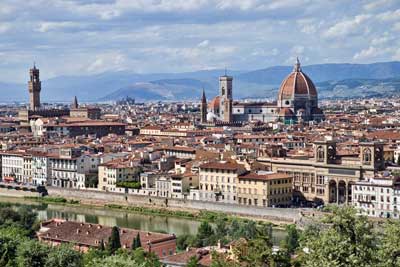
Rome also lives up to the hype and spending a day in the Vatican City will be a highlight even for non-Catholics, but it’s also a crowded and busy city so three days is usually enough for most people. Similar to Paris, Rome is an unusually beautiful city from almost any angle when you are in the historical center. You’ll walk through a stunning piazza (town square) and then turn a corner and you’ll see gorgeous buildings or public statues that are as nice as anything in the museums. Seriously, it’s worth a visit.
Paris to Venice flight: 1 hour 35 minutes
Venice to Florence by train: 1 hour 53 minutes
Florence to Rome by train: 1 hour 16 minutes
You can of course instead fly from Paris to Rome and then go north to Florence and then to Venice and fly home (or back to Paris) from there, and it would be just as enjoyable.
Best add-ons to Paris and Italy
France
- Nice/Cannes/Monaco (2 or 3 nights)
- Avignon (2 nights)
- Bourges (2 nights)
- Bordeaux (2 nights)
- Aix-en-Provence (2 nights)
- Reims (2 nights)
- Dijon/Burgundy (2 nights)
Italy
- Milan (1 or 2 nights)
- Lake Como (2 nights)
- Siena (2 nights)
- Cinque Terre (1 night)
- Naples/Sorrento/Amalfi Coast/Pompeii/Capri (3 to 5 nights)
- Sicily (3 to 4 nights)
>>>Much more information in this article about the best France and Italy itineraries
>>>Check Paris hotel deals
>>>Check Venice hotel deals
>>>Check Florence hotel deals
>>>Check Rome hotel deals
Itinerary 4: Mediterranean cruise
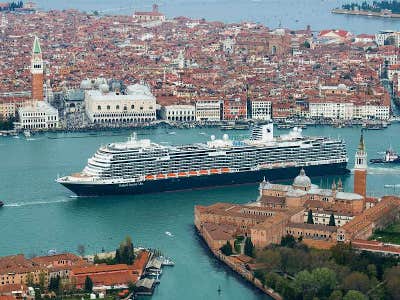
In spite of the reputation of cruises to be floating buffets, they can actually be an excellent way to visit a great number of amazing European cities in a short time. The ship typically is in port from the early morning until mid evening, often giving you the opportunity to have dinner in the city (unlike Caribbean cruises). Better still, the cruise ports are often near the center of town, so you can just walk off the ship and do sightseeing on foot or by public transportation.
Mediterranean cruises usually start at 7 nights but can go up to 3 weeks, which can provide an amazing tour of the entire region without having to pack and repack your bags more than once. They also can provide excellent value, especially compared to the price of taking trains or flights and finding new hotels in every destination.
Most popular Mediterranean departure ports
Barcelona, Spain – It’s an easy port to reach. Ships generally go from Barcelona with stops in France and then Italy.
Rome (Civitavecchia), Italy – The port isn’t very close to Rome, but it’s easy to get back and forth. Ships go west to France and Spain as well as south around the tip of Italy and then on to Croatia, Venice, and to Greece.
Venice, Italy – The cruise ships no longer dock close to the best tourist areas, but it’s easy enough to visit Venice for a day or two before boarding a ship. Ships starting in Venice go south and then head west and to Rome and then to France, or they go south to Croatia and then head east to Greece.
Athens, Greece – The cruise port of Piraeus is just south of Athens and easy to reach. Ships from Athens usually head west towards Croatia, Italy, France, and Spain, but there are also ships that visit Greek islands and Turkey.
>>>Check for deals on Mediterranean cruises
Alternative to consider: a river cruise
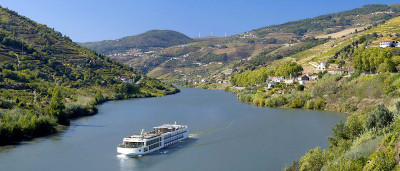
Amsterdam, Budapest, and Prague are some of the most popular river cruise ports, but there are dozens of others including many smaller towns in France where few other tourists will be when you stroll off the ship. There is little or no entertainment on the river cruise ships, but passengers don’t miss it because the entire day and into the evening is spent just steps from local cultural offerings and restaurants.
>>>Check for Europe and river cruise deals
Itinerary 5: France, Belgium, and Netherlands
Paris to Brussels: 1 hour 22 minutes
Brussels to Bruge: 58 minutes
Bruges to Amsterdam: 2 hours 45 minutes
Amsterdam to Paris: 3 hours 17 minutes
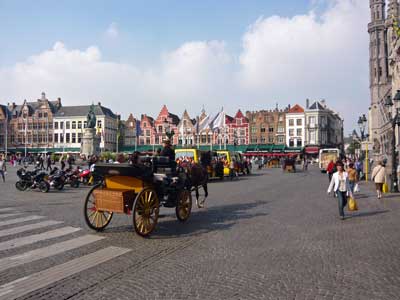
Spending 4 nights in Paris and 3 nights in Amsterdam would be a great trip, but if you want to see something else you’ve got a couple options in between. My advice is to spend an afternoon looking around the Grand Place (main square) in Brussels and then hop a 58-minute train ride to Bruges for a night or two. Brussels isn’t a great tourist city, but Bruges really is so it’s a better option for most people. Whatever you choose out of this group, you can be back in Paris on another high-speed train for your flight home.
Best add-ons to France, Belgium, and Netherlands
- Luxembourg City (1 or 2 nights)
- Cologne, Germany (1 or 2 nights)
- London (3 or 4 nights)
- Interlaken, Switzerland (2 or 3 nights)
>>>Check Paris hotel deals
>>>Check Bruges hotel deals
>>>Check Amsterdam hotel deals
Itinerary 6: Paris and elsewhere in France
- Paris (3 or 4 nights)
And a choice of:
- Nice/Cannes/Monaco (2 or 3 nights)
- Avignon (2 nights)
- Bourges (2 nights)
- Bordeaux (2 nights)
- Aix-en-Provence (2 nights)
- Reims (2 nights)
- Dijon/Burgundy (2 nights)
- Normandy (2 nights)
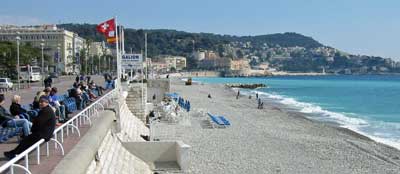
While Nice is a wonderful tourist city for a look at the French Riviera, the other larger cities of Lyon and Marseilles are probably better saved for a future trip because they are light on key sights compared to many smaller towns. Wine lovers can rent a car or take trains into Bordeaux or Burgundy. Since you can get between most of these towns by train in 2 hours or less, spending only 2 nights in each one is a reasonable option if you want to see a lot in a short time.
Normandy is an interesting choice and easy to reach in only about two hours by train from Paris. Some visitors like to see the famous WWII beaches and memorials, while others (especially in summer) like to check out one or more of the beach-resort towns. Deauville is one of the more famous of those, and it’s also famous for its horse race track and as one of the epicenters of the industry in Europe.
Best add-ons to Paris and elsewhere
- More France, of course
- London (3 or 4 nights)
- Interlaken, Switzerland (2 or 3 nights)
- Amsterdam (2 or 3 nights)
>>>Check Paris hotel deals
>>>Check Nice hotel deals
Itinerary 7: Italy
Rome to Florence: 1 hour 16 minutes
Florence to Venice: 1 hour 53 minutes
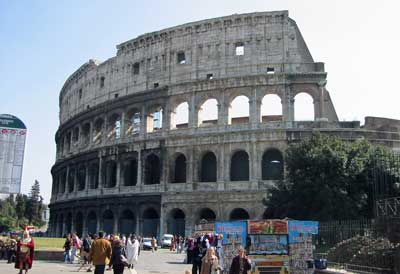
Venice is small enough that you can see the main sights in about 24 hours, and it’s so insanely crowded that many people tire of it after about a day as well. It’s better to pay more for a hotel to be on the main island and visit quickly than to save money with a hotel on the mainland where you’ll be in crowds going back and forth as well. Florence is the most relaxing of the 3, and also a great base for side trips to Pisa, Siena, and Cinque Terre, just to name a few.
Going to Italy? Here are the best first-time Italy itineraries for 3 days to 2 weeks (in much greater detail)
Best add-ons to Italy
- Milan (1 or 2 nights)
- Lake Como (2 nights)
- Siena (2 nights)
- Cinque Terre (1 night)
- Naples/Sorrento/Amalfi Coast/Pompeii/Capri (3 to 5 nights)
- Sicily (3 to 4 nights)
>>>Check Rome hotel deals
>>>Check Florence hotel deals
>>>Check Venice hotel deals
Itinerary 8: Spain
Madrid to Barcelona: 2 hours 30 minutes
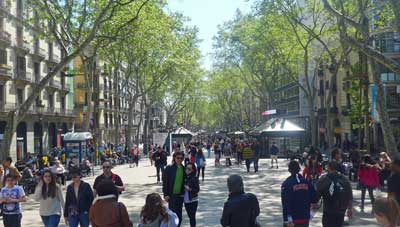
A huge part of Spain’s tourism industry is built around its southern beaches and islands such as Ibiza, Mallorca, and Tenerife (in the Canary Islands). For most people it’s best to ignore those places on your first trip because none of the beaches are special enough to spend days on them compared to the culture of the cities.
Best add-ons to Spain
By popular demand, I’ve added a full article on where to go in Spain with itineraries from 7 to 10 days up to two weeks.
>>>Check Madrid hotel deals
>>>Check Barcelona hotel deals
>>>Check Lisbon hotel deals
Itinerary 9: Germany
Berlin to Munich: 6 hours 2 minutes
Munich to Rothenburg ob der Tauber: 2 hours 56 minutes
Munich to Füssen: 2 hours 4 minutes
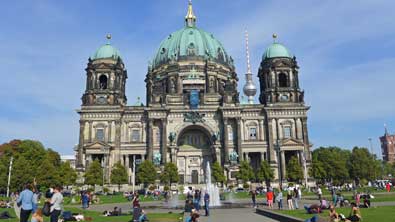
Those two cities are the keys to a Germany visit, and after that you’ve got a wide variety of choices. I cover most of the popular choices in my article on where to go in Germany, which covers several smaller towns that are major highlights.
Best add-ons to Germany
- Cologne (1 or 2 nights)
- Hamburg (2 or 3 nights)
- Amsterdam (3 nights)
- Prague (3 nights)
- Salzburg (2 or 3 nights)
- Vienna (3 nights)
- Interlaken, Switzerland (3 nights)
- Lucerne, Switzerland (2 or 3 nights)
>>>Check Berlin hotel deals
>>>Check Munich hotel deals
Itinerary 10: Switzerland
- Interlaken (3 nights)
- Bern (1 night)
- Lucerne (3 nights)
Zurich Airport to Interlaken: 2 hours 10 minutes
Interlaken to Bern: 53 minutes
Bern to Lucerne: 1 hour 50 minutes
Lucerne to Zurich Airport: 1 hour 3 minutes
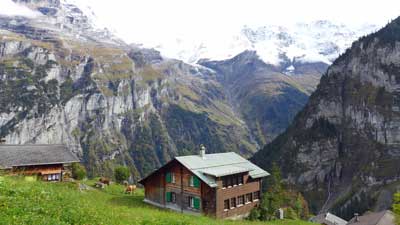
Interlaken is the best hub for the most dramatic Alps views and experiences. The one-hour cable car ride up to the Schilthorn observation deck is something you’ll never forget, and the only thing that might be more dramatic is the train ride up to the Jungfraujoch station, which is the highest in Europe. Lucerne is almost as beautiful with a scenic lake at its heart and also great mountaintop views nearby. If you do want to see a Swiss city then the capital of Bern is the most interesting and photogenic on a short visit. Read more about where to go in Switzerland for even more ideas.
Best add-ons to Switzerland
>>>Check Interlaken hotel deals
>>>Check Lucerne hotel deals
Itinerary 11: Eastern Europe’s best cheap cities
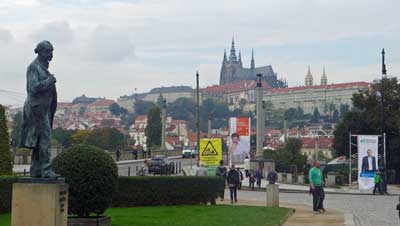
Each of these cities is beautiful and historic, but English is less widely spoken so they can also be quite a bit more challenging for a first-time visitor. Another difficulty is that the trains between them are still quite slow compared to the high-speed rail in the West, so it takes most of a day from one to another, and a bus is often a better choice. I cover this best cheap Europe itinerary more fully in the linked article.
Prague to Budapest: 6 hours 41 minutes
Budapest to Krakow: 9 hours 54 minutes (flying might be better)
Best add-ons to cheap Eastern Europe
- Cesky Krumlov, Czechia (2 nights)
- Ljubljana, Slovenia (2 or 3 nights)
- Split, Croatia (3 nights)
- Belgrade, Serbia (2 or 3 nights)
- Sarajevo, Bosnia and Herzegovina (2 or 3 nights)
- Sofia, Bulgaria (2 or 3 nights)
>>>Check Prague hotel deals
>>>Check Budapest hotel deals
>>>Check Krakow hotel deals


Hi Roger,
Thank you very much for your advice, i will look into the train prices well in advance, especially discovering that the flight prices are quite high!
What do you think that we spend less days in Switzerland (knowing it is expensive there) and instead place it to more days in Budapest and Prague?
Also, from Switzerland would it better/cheaper to travel to Rome first before Venice?
Thank you!
Darlene
Darlene,
Shifting some of your days from Switzerland to Budapest and Prague will definitely save you some money. For the most thrills in the shortest time I’d recommend three nights in the Interlaken area and then moving on. The train from Interlaken into Italy is a really beautiful ride itself. The train goes to Milan and from there it’s shorter and cheaper to go to Venice first and then Rome after that, but you could do it in the other order if you prefer. Let me know if you have any other questions. -Roger
Hi Roger,
Hope you are well. My family and I are planning a 1 month trip to Europe in mid January/Feb 2020 so it will be winter! We are flying in from Australia to London first and was wondering if this is the best route to follow. I’ve made an itinerary below:
1. London (3 nights)
2. Paris (2 nights)
5. Switzerland (5 nights)
6. Venice (2 nights)
7. Rome (3 nights)
8. Salzburg (2 nights)
9. Vienna (2 nights)
10. Budapest (2 nights)
11. Prague (2 nights)
12. Berlin (3 nights)
13. Amsterdam (2 nights)
Is there any place you recommend spending more or less time in? And do you also recommend buying the Global Euro Pass for travelling to these cities? We are thinking of using the train for most cities but probably need to buy flights for Rome to Vienna, Budapest to Prague and Berlin to Amsterdam?
Please let me know what you think. Thank you so much for your advice
Rgds
Darlene
Darlene,
This looks like an epic trip. First off, this comes up a lot and my strong advice is to plan 3 nights in almost any European city you visit for the reasons mentioned in that article. The short version is that you can’t do much sightseeing on the day you arrive or leave, so two nights in a city is essentially one full day in that city.
Venice is actually small enough to appreciate in about 24 hours, but the others are your list are all quite large so exploring them in only one full day would be challenging. I’d say Salzburg and even Vienna could be done in two nights if you are focused.
As for transport, you’d definitely want to fly from Rome to Salzburg. From Budapest to Prague the train takes about 6.5 hours and from Berlin to Amsterdam it’s a bit over 6 hours. Personally, I’d take the train on both of those because the flight typically takes 5 to 6 hours from city center to city center (including airport transportation and being there early to go through security), and trains are FAR more enjoyable and comfortable than those short flights. The scenery on both of those is fairly plain (mostly flat and pretty brown in winter), but still I vastly prefer the train option if the timing and cost are similar. It’s so nice to have, say, a 10am train and walk into the train station at 9:50am knowing you have plenty of time and a comfortable seat waiting for you with no security hassles. And when the train pulls in you simply walk off and you can be in a bus or taxi to your hotel within a few minutes.
Eurail Passes are best for longer trips where you want to make plans as you go. If you can buy tickets at least a month or more in advance they are usually surprisingly cheap, so that’s what I’d recommend. Some of your train rides are a bit pricey, but others (Venice to Rome, Budapest to Prague to Berlin) will be pretty cheap. You can compare the fares to the Eurail Pass just to be sure. Let me know if you have any other questions. -Roger
Hi Roger,
Thank you for your response.
My itinerary is as follows:
Amsterdam – 3N
Paris – 3N
Innsbruck – 2N
Salsburg – 3N
Venice – 2N
Florence – 2N
Rome – 2N
Would you suggest any shuffling ? What all places/add ons would you suggest to cover major attractions ?
Should I consider Belgium, since it would fall in between ?
Regards,
Shashank Jain
Shashank,
If I were you I’d skip Innsbruck and add an extra day to Florence and to Rome. Innsbruck is mainly a skiing destination in winter and aside from that there isn’t much to see. Salzburg is fantastic though so you’ll be getting a lot of flavor of Austria there.
I think skipping Belgium on this trip is wise. Honestly, Brussels isn’t a great tourist city (it’s mostly filled with government employees and big companies). Bruges is a charming town, but it’s from the same era as Amsterdam so they look quite a bit alike. You can visit Belgium on a future trip. Otherwise your itinerary looks great and that order will work well for train travel, with a highlight being the train from Salzburg to Venice going through the Alps. Let me know if you have any other questions. -Roger
Hi Roger,
This is with regards to the response which you had provided on 25th March 2019.
First of all, bug thank you for the helpful information and the website. I hope you are doing well. Now, I have decided 4 countries to visit in AUG – SEP 2019. I wish to start with Paris, then Netherlands, then Austria and Italy. I would have roughly 16 days with me.
We don’t want a rush rush trip. We want to relax whereever we want go, therefore, we made our preference as 3 nights in Paris, 5 Nights in Netherlands, 4 Nights in Austria and rest 4 nights in Italy. Is this looks ok to you ? Travelling from one country to another is something which I am not sure of, whether it saves time or not.
What other places/add-ons would you suggest and what should be the order. Please suggest.
Regards,
Shashank Jain
Shashank Jain,
I agree that not rushing is going to be more enjoyable, so I like your plan. As for the order, it can be done in many ways and be about the same efficiency. Paris and Amsterdam are about 3.5 hours apart by high-speed train so you can fly into one and take the train to the other. Unfortunately, the trains from Paris or Amsterdam to Salzburg or Vienna take more than 8 hours and they are fairly expensive so it’s best to fly.
From Salzburg to Venice the train takes a bit over 5 hours, but it goes through a very scenic part of the Alps so it’s highly recommended. Then from Venice to Rome the train only take about 3.5 hours and it’s fairly cheap if you buy in advance. So you could go Paris to Amsterdam then fly to Vienna then a train to Salzburg then a train to Venice and finally a train to Rome for your last 3 days. That is the most efficient and enjoyable way to do it. Let me know if you have any other questions. -Roger
Hi Roger!
Your post has been incredibly helpful. My wife and I are planning our vacation to Europe towards end of September/early October. We are going for 2 weeks. I would love to tackle London, Paris and Italy. I thought fly into London, stay for 3 nights. Then head to Paris for 3 nights. Then to Italy to see Venice and Rome, possibly even another stop.
Could use some of your expertise to see if I’m being too ambitious, or should I just do Paris and Italy and eliminate London?
Thanks!
Israel,
Actually, your plan sounds fantastic and very common. And late September is a great time to visit Italy in particular because the weather is nice and the crowds thin out a bit. I’d fly into London and spend 3 or 4 nights there and then take the Eurostar train to Paris for 3 or 4 nights. Then fly to Venice (or nearby Treviso) for about 24 hours in Venice. Then take a train to Florence for 2 or 3 days and then a train to Rome for your last 3 days. That is a classic trip loaded with highlights. I’m happy to help if you have other questions. -Roger
Hi, we are a group of 10 adults and 1 kid planning for Europe trip. is it more cheaper if we hire minivan with driver compare to taking train?
Thela,
All of the vehicles in Europe tend to be fairly small, and a “minivan” would only hold about 7 people including a driver. For 11 people plus a driver you’d have to hire a full-size van and even then it might be tight. As for the cost, it depends on which country you’d do it in. In, say, Greece, you could probably hire a van and a driver for a very reasonable price, but in Switzerland or France or Italy it could be more expensive than 11 train tickets. Fuel is also expensive and many roads in some countries have tolls. Train travel tends to be easy and very pleasant. If you buy your train tickets far enough in advance they also are usually surprisingly cheap. I hope this helps. Let me know if you have any other questions. -Roger
Hi Roger,
I am planning on booking a Europe trip for my partner and I after our wedding. We are looking at approximately 5 weeks in May 2020. We are flying from Australia.
We want to visit the following cities: Rome, Venice, Prague, Paris, Berlin, Amsterdam – We are open to visiting other cities but these are the ones which we must visit.
We are looking at the following itinerary:
Rome – 3-4 nights
Venice – 2 nights
Prague – 3 nights
Berlin – 3 nights
Amsterdam – 3 nights
Paris – 3-4 nights
UK – 6 nights total
I have family in the UK so ideally I would like to do Manchester/London at the end of the trip and fly back to Australia via the UK.
Do you think this amount of time in each place is suitable, and which ‘legs’ would you recommend travelling by train, or by flight?
Thank you for your help, it is much appreciated.
Martin
Martin,
Your itinerary looks great and I think the amount of time in each place is perfect. You can do most of it by train, which will make the trip even better as those trains are usually an enjoyable part of a Europe trip, while flights tend to be stressful and unpleasant as they are everywhere else. In fact, if you add Austria to your itinerary you could do it pretty much all by train.
Start in Rome and then take a train to Venice. From there you can take a lovely train through the Alps to Salzburg or Vienna or both. Personally I’m more a fan of Salzburg and it would be great to get some mountain scenery mixed in with all the cities. Then you can take a train from Salzburg or Vienna to Prague and then a train to Berlin and a train to Amsterdam and a train to Paris and then the Eurostar train from Paris to London. It will all fit very nicely in 5 weeks. Let me know if you have any other questions. -Roger
Hi Roger,
I have a planned family trip(Wife and 5yr old kid) to Europe in July. The total duration is 15 days with arrival and return from Paris. I am planning to cover Paris, Switzerland, Austria and Italy. Combining in a way to spent 20% time on a beach destination. I want your suggestion on which all cities should I cover in all these countries with moderate or less budget. I also dont want to end up not enjoying countries visited while hopping them..please guide the best way to cover them all and suggest the ones to skip TIA 🙂
Divyank,
One challenge is that there aren’t many beaches on the route you are choosing. I highly recommend spending 3 nights in each place you visit as the best way to see a lot without spending half your time on trains and in train stations. So in 15 days you should visit 5 cities. Start in Paris for 3 nights and then you can take a train to Interlaken for 3 nights to see the best views of the Alps. Switzerland is very expensive though, so it will push your budget.
As for Italy, the “Big 3” destinations that most people rightly focus on are Venice, Florence, and Rome. You can enjoy Venice is about 24 hours because it’s compact (and crowded) and then head to Florence and Rome for 3 days each. The beaches in Italy will all be packed with locals in July, and there are very few sandy beaches in the first place, so it’s hard to recommend something. If spending a few days on a beach is a high priority it might be best to drop something else and fly to Barcelona or Valencia for a few days. Both cities actually have nice beaches and plenty of things to see and do in town. Let me know if you have any other questions. -Roger
Hi Roger!
I am really amazed at the knowledge you possess about destinations in Europe and most of all the willingness to help others and the patience with which you reply to each and every query is particularly appreciable.
I’m planning my first trip to Europe in October this year.I will be in Porto, Portugal in the last week of September on official work and after that I will have about 4-5 weeks for travel.
My rough itinerary was to do Portugal and Spain for 3 weeks(including Gibraltar), 1 week in Morocco and a week in Amsterdam.Can you please suggest a good itinerary for the same.I’m doing my research on the same.Im travelling solo for most of the trip.
Or should I do Central Europe instead?(Germany,Poland,Austria,Hungary,Czech Republic,Slovakia & Slovenia)I am in a dilemma!
I will be waiting eagerly for your reply.
With love and respect,
Shreyas
India
Shreyas,
I’m happy to try to help. I think your plan is quite good as it is. You should spend at least 3 nights in Lisbon before going to Spain. It might be best to fly from Lisbon to Madrid and then take high-speed trains from there. I highly recommend 3 nights in pretty much any city you visit, although a place like Gibraltar is small enough to enjoy in a day or two. The coast of Spain is pretty quiet by the time you will get there so I’d focus on Madrid, Seville, Granada, Barcelona, and Valencia.
In Morocco you could stop for a couple days in Tangier when you get off the ferry. From there you can take a train to Marrakesh, Fez, or both. They are both very touristy and interesting cities and visiting one or the other might be better. Marrakesh is more popular, for what it’s worth. I really love Amsterdam, but a full week there is a long time. Most people can see the main sights in 3 or maybe 4 days. I’d think about stopping a few days in Paris if you haven’t been there before.
Central Europe would be cheaper, but I’d save that for another trip and go with your first choice if you can afford it. I hope this gives you something to start building a full itinerary with. Let me know if you have other questions. -Roger
Hi Roger,
Thank you for your reply.
This is itinerary so far:
Starting with London – 6 nights (with family) 5th -11th September
Rome – 5 nights (with family) 11th -16th September
Venice – 2 nights (with family). 16th -18th September
BLANK – should we go to Salzburg or Vienna before heading to Prague for 3 nights, OR choose to go to Berlin for 3 nights after Prague instead?
I’ve read so many reviews and I’m a bit flustered. I can’t book Prague accommodation until I can decide on which other country to add in.
Prague – 3 nights Either the 18th – 21st September or 21st – 24th September? Depending whether we choose Austria or Berlin
Amsterdam – 3 nights 24th – 27th September
Paris – 4 nights 27th September – 1st October
From Paris, train it to London airport to fly home to Australia.
Maybe through in a wild card country suggestion that you believe is worth seeing either before or after Prague.
Thanks Roger, advice would be appreciated. (Frustrated traveller)
Susie,
I know how frustrating planning trips like this can be, especially on your first visit there. The good news is that all of the places you are choosing between are amazing destinations, and you’ll love any and all of them. It sounds like we are deciding between Vienna, Salzburg, and Berlin. I’ll give you my thoughts on those three places and hopefully one will stand above the others.
Vienna is my least favorite of the three. It’s a beautiful “grand” and important city, but to me it feels a bit stodgy. People go there for architecture and opera and waltzes. The nightlife (bar scene) is mostly very mellow and traditional.
Salzburg is gorgeous and really fun. It’s the home of Mozart, but also the setting for the Sound of Music movie. Even if you haven’t seen the movie, the bus tours taking visitors around to the various filming locations around the area are really fun and a great way to see some stunning Alpine countryside. The old town area is extremely charming as well. If you aren’t going to Switzerland or other Alps areas this could be a great place to see a bit of that. The nightlife here is also pretty tame, though there are some really fun beer halls and beer gardens that are unlike anything you’ll see outside of Austria or Germany.
Berlin is far larger than the other two, and a bit cheaper as well. Perhaps the most interesting thing about Berlin is that more than half the city has had a chance to reinvent itself since the 1989 fall of the Berlin Wall. It feels a bit like a huge art community and there are surprises around every corner. The nightlife is great and so is the food scene. Most of it is the opposite of traditional. It’s really fun and kind of quirky. For some people it’s their favorite city in Europe, while other people could find it a waste of time.
Seriously though, you’d love and appreciate Vienna and the other two are great as well. I think those are your best choices so I won’t add a new one to the list. As always, let me know if you have any other questions and I hope this helped. -Roger